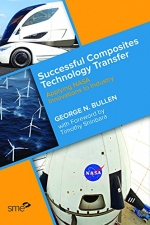The ingenuity and visibility of NASA space programs, such as the max launch abort system (MLAs), are sparking the creativity, knowledge transfer, and unique applications of revolutionary technologies in areas such as aerospace, wind energy, transportation, oil, safety, and civil infrastructure.
Lightweight, high-strength, carbon-fiber composites materials, vacuum-assisted resin transfer molding, smart sensors, out-of-autoclave curing of autoclave composites, unified structures, structural health monitoring systems, smart phone/rfid tracking, determinant assembly, forensic engineering, and the digital tapestry that ties everything together are just a few of the technological advances perfected in NASA’s programs. Successful composites technology transfer takes the discussion of these technologies to the next level — addressing the advantages and challenges to their more widespread industrial application.
Readers will get insight into how high-strength, carbon-fiber composites and its related technologies are making inroads into products such as commercial airplane seats and carts, turbine blades, firefighting equipment, trucks, buses, lifting and support devices, and containers. The author shares breakthrough thinking on other potential applications, such as a new lighter than air ship, prototype vehicles, driver health and safety, firefighter safety, and bridge infrastructure safety and health monitoring.
According to Foreword author, Tim Shinbara, vice president of manufacturing technology at AMT (Association for Manufacturing Technology), “...it is of considerable value to search out, discover, and digest resources such as this book in an effort to continually improve the lens by which we innovate.” Aside from new product innovations, extension of the manufacturing technologies, and processes described herein have the potential to not only add new functionality or modify the existing functionality of existing products and systems, but in many cases, adoption would require minimal effort from the manufacturing enterprise.
Foreword
About the Author
Preface
Acknowledgments
Chapter 1 : Introduction
Chapter 2 : Overview of Composites in Space Launch Vehicles
Chapter 3 : Composites Inhabited Space Vehicles
Chapter 4 : Composites in Uninhabited Space Vehicles
Chapter 5 : Max Launch Abort System (MLAS)
Chapter 6 : MLAS Quality Assessment of Parts
Chapter 7 : MLAS Vehicle Assembly
Chapter 8 : MLAS Transportation, Packaging, Handling, and Shipping
Chapter 9 : MLAS Project Management and Analysis
Chapter 10 : Unified and Large Structure Manufacture
Chapter 11 : Extensibility : Prototypes and Innovations
Chapter 12 : The Digital Tapestry
Chapter 13 : Epilogue
Appendix : Abbreviations
Index

























